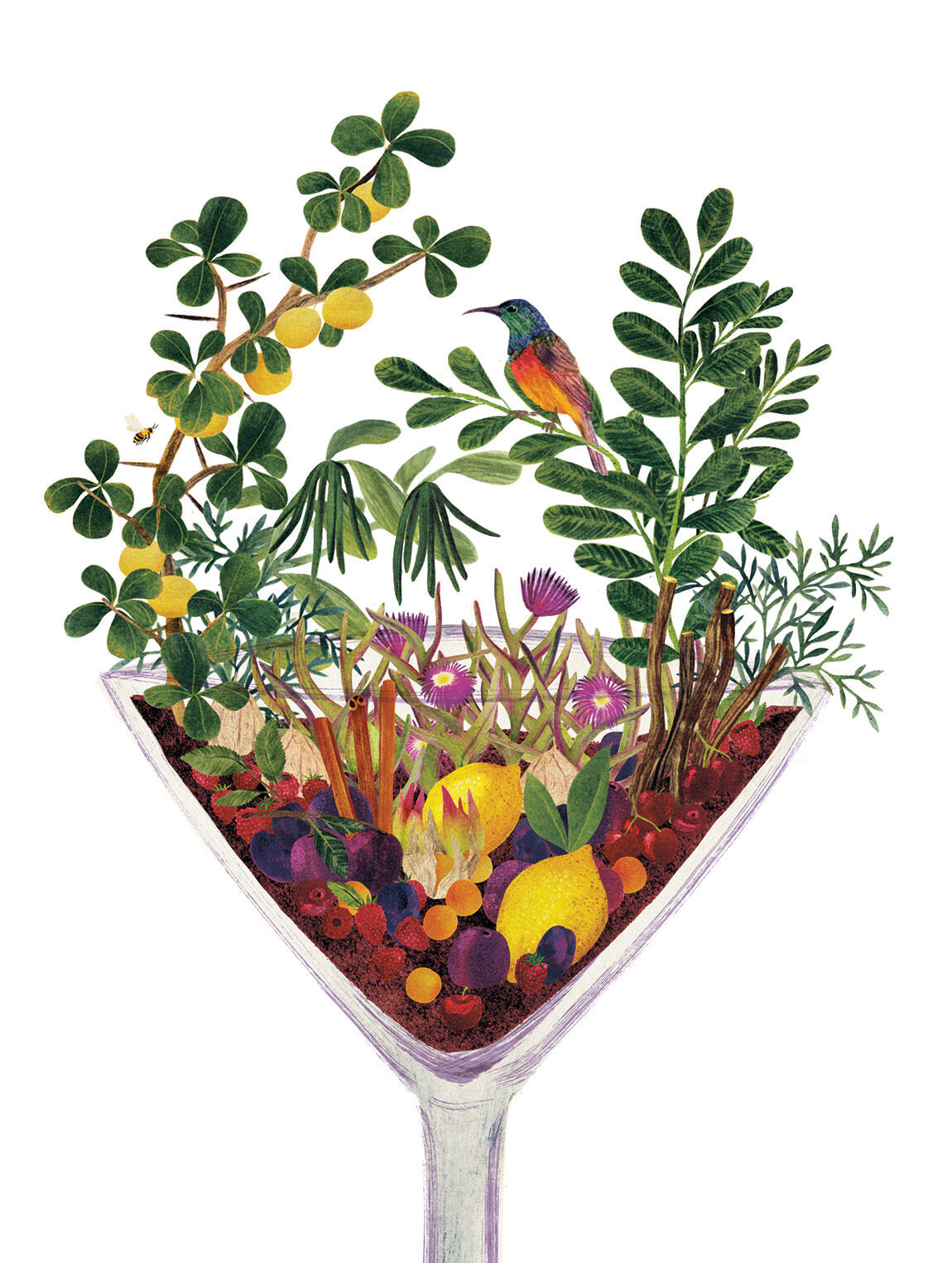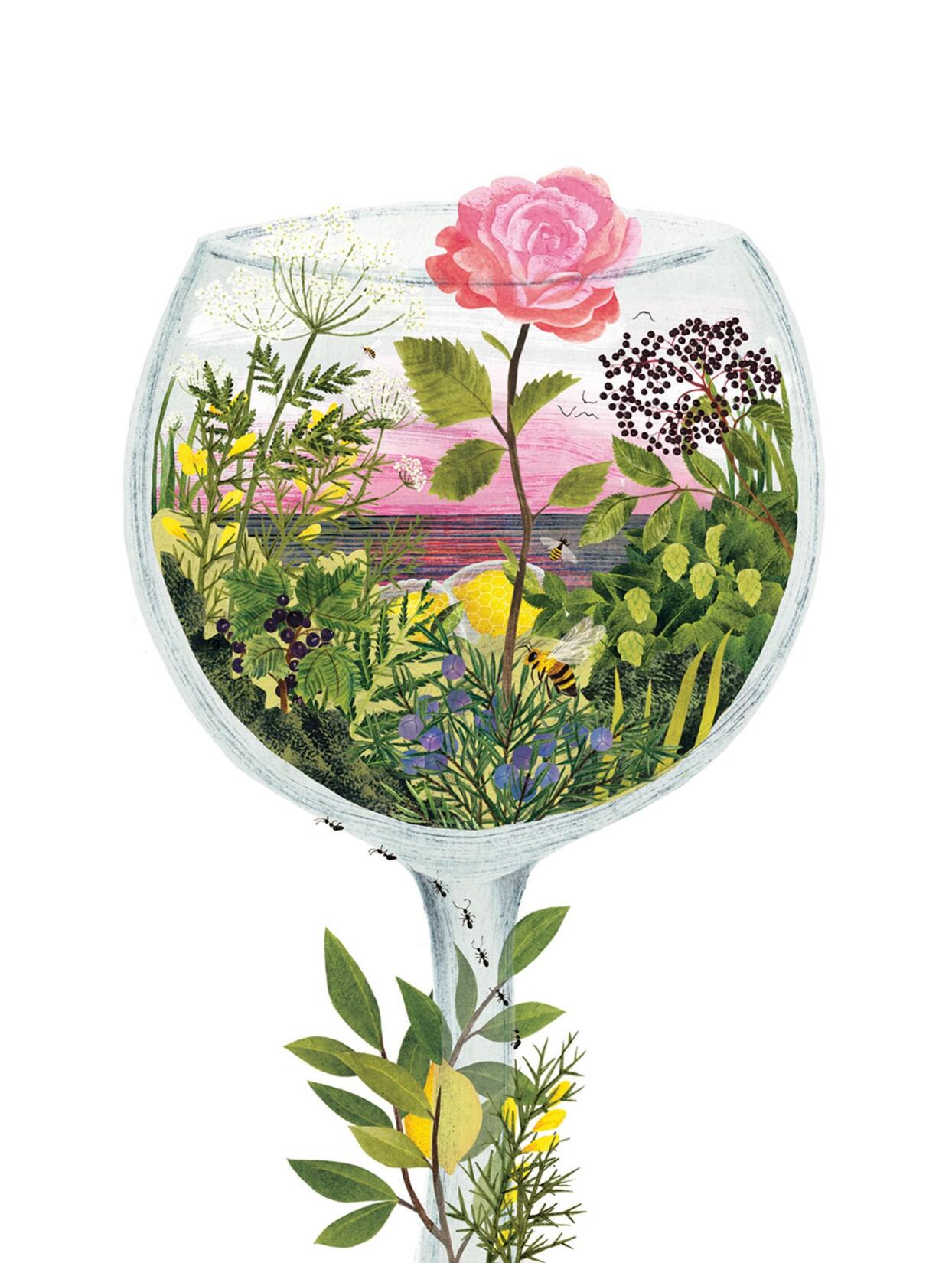Twelve drinks of Christmas 2025
Discover the flavours and colours of this years Twelve Drinks of Christmas, as explained by local mixologist Meg Clark.
Read moreWhen it comes to flavouring our favourite tipples, juniper berries or wormwood are just the tip of the iceberg. Drinks writer Alice Lascelles dives into the delicious world of botanical experimentation.

Illustration by: Hannah Bailey
The history of drinks is, in many ways, also a history of plants. From the grapes trodden into wine by the ancient Romans, and the juniper used by Londoners to flavour 18th century gins, through to the micro-herbs tweezered by bartenders onto 21st-century cocktails, plants have played an integral part in the evolution of liquid culture.
Every great drink starts with a plant. Every advance in botanical exploration or horticultural science has brought with it a corresponding uptick in the quality of our spirituous liquors
These days, we add botanicals to drinks, because they give us pleasure – but in centuries gone by, herbs, fruit and spices were often added to drinks in the belief that they would do you good. Wormwood, in particular, was regarded as a herb that could cure many ills. The Greek physician Hippocrates famously prescribed wine infused with wormwood and dittany for ailments including rheumatism, anaemia and indigestion. Archaeologists have found evidence of the Chinese making elixirs from rice wine macerated with wormwood, chrysanthemum and elemi, as far back as 1000BC. And diarist Samuel Pepys also wrote about taking his ‘morning draft’ of wormwood-spiked ale, a restorative known as ‘purl’.
One of the great legacies of these drinks is vermouth, an aperitif which started life in 18th century Italy, and which is now experiencing a wonderful renaissance in distilleries around the world. In its simplest form, vermouth is just a fortified, sweetened wine flavoured with bitterest wormwood. But most vermouths are flavoured with dozens of botanicals. At the Sacred Distillery in north London, they make an amber vermouth from English wine and botanicals including thyme, savory, cherry and plum stones. The South African vermouth Caperitif, meanwhile, is laced with more than 35 ingredients harvested from around the Western Cape: sour figs from the dunes, citrusy naartjies, cape gooseberries, kei apples. There are vermouths flavoured with lemon verbena, lavender, citrus peels, cinnamon, raspberries, vanilla, nutmeg, liquorice, rosemary and even myrrh.
Some of these recipes read more like perfumes than drinks. And there was a time when perfumes and libations were almost interchangeable (distillation was, after all, invented not to make strong liquor, but to capture essences to make scent). The earliest eau de colognes, with their uplifting notes of citrus, exotic flowers and herbs, were elixirs designed to be worn or imbibed. In the 19th century, there was also a fashion for adding ambergris – a rarity more often used by perfumers – to alcoholic punch.
Drinkable perfumes might be thin on the ground these days. But there are plenty of unusual spirits that still allude scent. Muyu is a new range of perfumery-inspired liqueurs that leads on notes such as jasmine and vetiver. At the Comte de Grasse distillery in Grasse, the heartland of France’s perfume industry, they make a gin flavoured with the kind of local flora usually destined for Guerlain or Chanel: lavender, mimosa, jasmine and sweet immortelle.
Sometimes botanicals can have the most unexpected, and delightful, side effects
Tinkture is a Cornish gin flavoured with organic David Austin roses grown in England. On its own, the gin is amber-coloured, but when the rose pigments come into contact with tonic water or lemon juice, the citric acid turns them bright pink.
“We even turned a few test distillations green when we tried different rose varieties… not exactly the look we were going for!” laughs Tinkture founder Hannah Lamiroy, who auditioned more than 190 different varieties of roses in her search for the perfect blend. “We were essentially looking for subtle, delicate aromas – when you taste our gin we want you to feel like you are taking a stroll through an English garden in bloom, not drowning in sickly perfume.”
Gin has traditionally been made with botanicals from all over the world: juniper from Tuscany, citrus peels from Spain, coriander from Morocco, liquorice from China. But more and more, we’re now seeing craft distillers shift their focus closer to home, using local, seasonal and foraged ingredients to give their recipes a strong sense of place. Cambridge Distillery produces a seasonal gin that changes twice a year: this year’s spring/summer edition was flavoured with wisteria, cow parsley and flowering currants, all hand-picked from the gardens and hedgerows around the distillery in Grantchester. When founder Will Lowe was commissioned to create a gin for the Nordic Food Lab – a think tank founded by Noma chef René Redzepi – he used formic acid derived from native woodruff ants to give the recipe a Scandinavian tang.
At her north London bar Tayēr + Elementary, International Bartender of the Year Monica Berg uses all kinds of unusual ingredients to give her drinks a culinary twist. “I always try to work with what’s around me, because it’s important to me to pay respect to the time and place I’m part of,” she says. “Some of my favourite ingredients are sea truffle (not to be confused with truffle seaweed ), sea buckthorn and green juniper – it’s always such a treat when they become available.”
If you’re having a drink in The Living Space, you’ll notice a rather fine limoncello behind the bar made by the nearby Atlantic Distillery – a recipe originally made using lemons grown in the Mediterranean biome at the Eden Project.
Demand for the liqueur has grown so much that they’re forced to use organic lemons from abroad these days, but the distillery still uses a wealth of local ingredients to flavour its gins, including hops, elderflower, gorse flower and its own homegrown fig leaves. But all this botanical activity isn’t just confined to alcoholic drinks – the burgeoning non-alcoholic sector is now producing some fascinating recipes, too.
Everleaf is a golden, non-alcoholic aperitif flavoured with more than 16 different botanicals including saffron, vetiver, orange blossom and voodoo lily. Created by conservation biologist-turned-bartender Paul Mathew, it’s bittersweet, fragrant and slightly fruity/floral: delicious with tonic water or soda.

Illustration by: Hannah Bailey
Or how about an alternative high? Three Spirit is a new herbal aperitif compounded from (fully legal) botanicals with a reputation for psychic enhancement: damiana, lion’s mane, yerba mate, tulsi. It tastes a little like a craft cola, or a rather earthy vermouth. Not an alternative G&T exactly – but after a couple of these I certainly found myself more than usually content to spend the evening just lying on the sofa, listening to records.
Some botanical drinks are outrageously extravagant. It takes an astonishing 1500 lotus flowers to scent just a kilo of Vietnam’s rare Lotus Lake Green Tea. But there are other drinks companies who are now finding new ways to be resourceful. Discarded is a new red vermouth that’s flavoured with cascara, or the fruit of the coffee berry, a by-product of coffee production that would otherwise go to waste. At Kwant cocktail bar in Piccadilly, they’ve cut down on air miles by growing all their micro-herbs in-house. Sitting at the black-lacquer bar, you can sip a sour topped with a tiny Mexican marigold, or a martini garnished with a peppery nasturtium leaf the size of a one pence piece.
“Every great drink starts with a plant,” says Amy Stewart, author of The Drunken Botanist, a hugely entertaining encyclopaedia of more than 160 plants that have shaped our drinks throughout history. “Every advance in botanical exploration or horticultural science has brought with it a corresponding uptick in the quality of our spirituous liquors.” Which sounds like a very good excuse to pour yourself a G&T, roll up your sleeves, and get out there in the garden.
Alice Lascelles writes about drinks for the Financial Times and is Fortnum & Mason Drinks Writer of the Year 2019.
Illustrations by Hannah Bailey
We'd love to keep in touch and send you the latest news, events, competitions and offers from the Bay. Sign up to receive our e-newsletter.